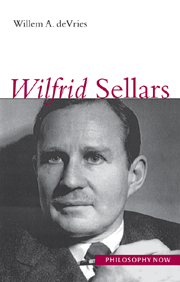Book contents
- Frontmatter
- Contents
- Preface
- Abbreviations
- 1 Sellars's philosophical enterprise
- 2 Sellars's philosophy of language
- 3 Categories, the a priori, and transcendental philosophy
- 4 Sellars's nominalism
- 5 Knowledge and the given
- 6 Science and reality
- 7 Intentionality and the mental
- 8 Sensory consciousness
- 9 Practical reason
- 10 The necessity of the normative
- Notes
- Bibliography
- Index
2 - Sellars's philosophy of language
- Frontmatter
- Contents
- Preface
- Abbreviations
- 1 Sellars's philosophical enterprise
- 2 Sellars's philosophy of language
- 3 Categories, the a priori, and transcendental philosophy
- 4 Sellars's nominalism
- 5 Knowledge and the given
- 6 Science and reality
- 7 Intentionality and the mental
- 8 Sensory consciousness
- 9 Practical reason
- 10 The necessity of the normative
- Notes
- Bibliography
- Index
Summary
Like most Anglo-American philosophers of the twentieth century, Sellars's reflections on language sit at the heart of his philosophy. Understanding language is absolutely essential in metaphysics: it holds the key both to the nominalism–Platonism debate and to a proper understanding of the nature of mind, especially the intentionality of thought. Consequently, it is also crucial in epistemology and the philosophy of science, for it is essential to understanding the mind's cognitive relation to the world. Sellars's treatment of meaning, in particular, is so central to his thought that it seems the best place to begin our detailed investigation of his philosophy.
A focus on language has been a major theme throughout contemporary Anglo-American philosophy. Rorty, for instance, makes a well-known distinction between ideal language and ordinary language theories. The ideal language approach sees constructing an ideally perspicuous language as a central task for philosophy. From such an ideal language we could read off important insights in metaphysics and epistemology. This strain of philosophical enquiry into language stems from Frege, Russell and the early Wittgenstein (especially in their logical atomist phase) through Carnap and Tarski, to Quine and David Lewis. However, the goal of an ideally perspicuous language seems elusive at best, and the relation of this ideal language to the rich multiplicity of the daily linguistic activities of ordinary people is very problematic.
Ordinary language approaches, in contrast, assume that ordinary language is perfectly “in order” and focus on the careful examination of language structures and usage.
- Type
- Chapter
- Information
- Wilfrid Sellars , pp. 23 - 56Publisher: Acumen PublishingPrint publication year: 2005



